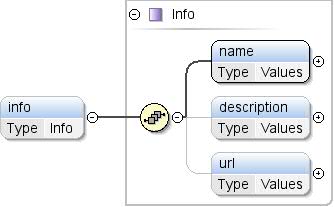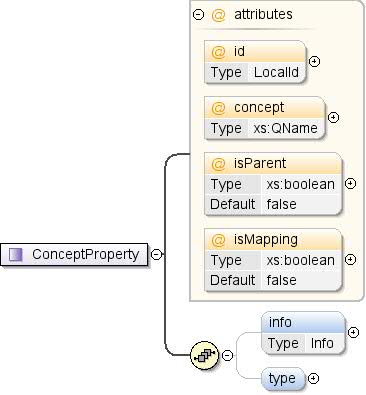Componente: ConceptProperty
Organiza tus páginas con colecciones
Guarda y categoriza el contenido según tus preferencias.
| Espacio de nombres |
http://schemas.google.com/dspl/2010 |
| Anotaciones |
Información textual sobre la propiedad del concepto. |
| Diagrama |
 |
| Tipo |
Información |
| Propiedades |
| content: |
complejo |
| mín.Ocurre: |
0 |
|
| Modelo |
nombre , descripción{0,1} , url{0,1} |
| Niños |
description, name, url |
| Instancia |
<info>
<name>{1,1}</name>
<description>{0,1}</description>
<url>{0,1}</url>
</info>
|
| Fuente |
<xs:element name="info" type="Info" minOccurs="0">
<xs:annotation>
<xs:documentation>Textual information about the concept property.</xs:documentation>
</xs:annotation>
</xs:element>
|
| Espacio de nombres |
http://schemas.google.com/dspl/2010 |
| Anotaciones |
El tipo de datos de la propiedad del concepto. |
| Diagrama |
 |
| Propiedades |
| content: |
complejo |
| mín.Ocurre: |
0 |
|
| Atributos |
|
| Fuente |
<xs:element name="type" minOccurs="0">
<xs:annotation>
<xs:documentation>The data type of the concept property.</xs:documentation>
</xs:annotation>
<xs:complexType>
<xs:attribute name="ref" type="DataType" use="required"/>
</xs:complexType>
</xs:element>
|
Tipo complejo: ConceptProperty
| Espacio de nombres |
http://schemas.google.com/dspl/2010 |
| Anotaciones |
Propiedad de un concepto (p.ej., el país de una
ciudad). |
| Diagrama |
 |
| Utilizado por |
|
| Modelo |
información{0,1} , tipo{0,1} |
| Niños |
información, tipo |
| Atributos |
| QName |
Tipo |
Fijo |
Predeterminado |
Usar |
Anotación |
| concepto |
xs:QName |
|
|
opcional |
Una referencia a un concepto que corresponde a los valores
de la propiedad. Si la propiedad especifica un tipo, entonces el tipo
debe coincidir con el tipo del concepto al que se hace referencia. Es una referencia a un
El concepto externo debe tener la forma
"prefix:other_concept_id", donde "prefix" es
el prefijo utilizado para el espacio de nombres del conjunto de datos externo (consulta XML
espacios de nombres). |
| id |
LocalId |
|
|
opcional |
Es el ID de la propiedad del concepto. Este identificador debe ser
únicos dentro del concepto (en todos los atributos y propiedades). El
id se puede omitir si se especifica la propiedad del concepto. En ese
En este caso, se crea implícitamente un ID con el valor local del nombre
al que se hace referencia. Por ejemplo <property
concept="geo:country"/> equivale a <property
id="country"
concept="geo:country"/> |
| isMapping |
xs:boolean |
|
falso |
opcional |
Si es verdadero, esta propiedad debe hacer referencia a un concepto.
esta propiedad denota una relación de asignación (1 a 1) entre
y el concepto al que se hace referencia. Cada instancia de la base de datos a la que se hace referencia
al menos una instancia de esta hace referencia
concepto. |
| isParent |
xs:boolean |
|
falso |
opcional |
Si es verdadero, esta propiedad debe hacer referencia a un concepto.
esta propiedad denota una relación jerárquica entre
así como el concepto al que se hace referencia (p.ej., el continente de un
país). |
|
| Fuente |
<xs:complexType name="ConceptProperty">
<xs:annotation>
<xs:documentation>A property of a concept (e.g., the country of a city).</xs:documentation>
</xs:annotation>
<xs:sequence>
<xs:element name="info" type="Info" minOccurs="0">
<xs:annotation>
<xs:documentation>Textual information about the concept property.</xs:documentation>
</xs:annotation>
</xs:element>
<xs:element name="type" minOccurs="0">
<xs:annotation>
<xs:documentation>The data type of the concept property.</xs:documentation>
</xs:annotation>
<xs:complexType>
<xs:attribute name="ref" type="DataType" use="required"/>
</xs:complexType>
</xs:element>
</xs:sequence>
<xs:attribute name="id" type="LocalId" use="optional">
<xs:annotation>
<xs:documentation>The id of the concept property. This identifier must be unique within the concept
(across attributes and properties).
The id may be omitted if the concept property is specified. In that case, an id is
implicitly created with value the local name of the referenced concept. For instance
<property concept="geo:country"/>
is equivalent to
<property id="country" concept="geo:country"/></xs:documentation>
</xs:annotation>
</xs:attribute>
<xs:attribute name="concept" type="xs:QName" use="optional">
<xs:annotation>
<xs:documentation>A reference to a concept that corresponds to the values of the property.
If the property specifies a type, then the type must match the type of the
referenced concept.
A reference to an external concept must be of the form "prefix:other_concept_id",
where "prefix" is the prefix used for the namespace of the external dataset
(see XML namespaces).</xs:documentation>
</xs:annotation>
</xs:attribute>
<xs:attribute name="isParent" type="xs:boolean" use="optional" default="false">
<xs:annotation>
<xs:documentation>If true, then this property must reference a
concept, and this property denotes a hierarchical
relationship between this concept and the referenced
concept (e.g., the continent of a country).</xs:documentation>
</xs:annotation>
</xs:attribute>
<xs:attribute name="isMapping" type="xs:boolean" use="optional" default="false">
<xs:annotation>
<xs:documentation>If true, then this property must reference a
concept, and this property denotes a mapping
(1-to-1) relationship between this concept and the
referenced concept. Each instance of the referenced
concept is referenced by at most one instance of
this concept.</xs:documentation>
</xs:annotation>
</xs:attribute>
</xs:complexType>
|
| Espacio de nombres |
No hay espacios de nombres |
| Tipo |
DataType |
| Propiedades |
| utiliza esto: |
obligatorio |
|
| Facetas |
| enumeración |
string |
|
| enumeración |
float |
|
| enumeración |
integer |
|
| enumeración |
boolean |
|
| enumeración |
fecha |
|
| enumeración |
concepto |
|
|
| Utilizado por |
|
| Fuente |
<xs:attribute name="ref" type="DataType" use="required"/>
|
| Espacio de nombres |
No hay espacios de nombres |
| Anotaciones |
Es el ID de la propiedad del concepto. Este identificador debe ser único
dentro del concepto (en todos los atributos y propiedades). El ID puede ser
se omite si se especifica la propiedad del concepto. En ese caso, un ID es
Se crea implícitamente con el valor el nombre local del concepto al que se hace referencia.
Por ejemplo, <propertyproperty="geo:country"/> es
equivalente a <property id="country"
concept="geo:country"/> |
| Tipo |
LocalId |
| Propiedades |
|
| Facetas |
|
| Utilizado por |
|
| Fuente |
<xs:attribute name="id" type="LocalId" use="optional">
<xs:annotation>
<xs:documentation>The id of the concept property. This identifier must be unique within the concept
(across attributes and properties).
The id may be omitted if the concept property is specified. In that case, an id is
implicitly created with value the local name of the referenced concept. For instance
<property concept="geo:country"/>
is equivalent to
<property id="country" concept="geo:country"/></xs:documentation>
</xs:annotation>
</xs:attribute>
|
| Espacio de nombres |
No hay espacios de nombres |
| Anotaciones |
Una referencia a un concepto que corresponde a los valores de la
propiedad. Si la propiedad especifica un tipo, el tipo debe coincidir con
del concepto al que se hace referencia. Una referencia a un concepto externo debe
tener el formato “prefix:other_concept_id”, en el que
"prefijo" es el prefijo que se usa para el espacio de nombres del
(consulta los espacios de nombres XML). |
| Tipo |
xs:QName |
| Propiedades |
|
| Utilizado por |
|
| Fuente |
<xs:attribute name="concept" type="xs:QName" use="optional">
<xs:annotation>
<xs:documentation>A reference to a concept that corresponds to the values of the property.
If the property specifies a type, then the type must match the type of the
referenced concept.
A reference to an external concept must be of the form "prefix:other_concept_id",
where "prefix" is the prefix used for the namespace of the external dataset
(see XML namespaces).</xs:documentation>
</xs:annotation>
</xs:attribute>
|
| Espacio de nombres |
No hay espacios de nombres |
| Anotaciones |
Si es verdadero, esta propiedad debe hacer referencia a un concepto, y esta
propiedad denota una relación jerárquica entre este concepto y el
concepto al que se hace referencia (p.ej., el continente de un país). |
| Tipo |
xs:boolean |
| Propiedades |
| utiliza esto: |
opcional |
| Predeterminado: |
falso |
|
| Utilizado por |
|
| Fuente |
<xs:attribute name="isParent" type="xs:boolean" use="optional" default="false">
<xs:annotation>
<xs:documentation>If true, then this property must reference a
concept, and this property denotes a hierarchical
relationship between this concept and the referenced
concept (e.g., the continent of a country).</xs:documentation>
</xs:annotation>
</xs:attribute>
|
| Espacio de nombres |
No hay espacios de nombres |
| Anotaciones |
Si es verdadero, esta propiedad debe hacer referencia a un concepto, y esta
propiedad denota una relación de asignación (1 a 1) entre este concepto y
el concepto al que se hace referencia. Cada instancia del concepto al que se hace referencia
al que puede hacer referencia, al menos, una instancia de este concepto. |
| Tipo |
xs:boolean |
| Propiedades |
| utiliza esto: |
opcional |
| Predeterminado: |
falso |
|
| Utilizado por |
|
| Fuente |
<xs:attribute name="isMapping" type="xs:boolean" use="optional" default="false">
<xs:annotation>
<xs:documentation>If true, then this property must reference a
concept, and this property denotes a mapping
(1-to-1) relationship between this concept and the
referenced concept. Each instance of the referenced
concept is referenced by at most one instance of
this concept.</xs:documentation>
</xs:annotation>
</xs:attribute>
|
Se crea con el
Editor XML de oXygen.
Salvo que se indique lo contrario, el contenido de esta página está sujeto a la licencia Atribución 4.0 de Creative Commons, y los ejemplos de código están sujetos a la licencia Apache 2.0. Para obtener más información, consulta las políticas del sitio de Google Developers. Java es una marca registrada de Oracle o sus afiliados.
Última actualización: 2025-07-25 (UTC)
[[["Fácil de comprender","easyToUnderstand","thumb-up"],["Resolvió mi problema","solvedMyProblem","thumb-up"],["Otro","otherUp","thumb-up"]],[["Falta la información que necesito","missingTheInformationINeed","thumb-down"],["Muy complicado o demasiados pasos","tooComplicatedTooManySteps","thumb-down"],["Desactualizado","outOfDate","thumb-down"],["Problema de traducción","translationIssue","thumb-down"],["Problema con las muestras o los códigos","samplesCodeIssue","thumb-down"],["Otro","otherDown","thumb-down"]],["Última actualización: 2025-07-25 (UTC)"],[],["ConceptProperty defines a characteristic of a concept, with optional `info` and `type`. The `info` contains text about the property, including `name`, `description`, and `url`. `type` specifies the data type. Attributes include an optional `id` for unique identification, an optional `concept` to reference related concepts, `isParent` (hierarchical relationship), and `isMapping` (1-to-1 relationship), both booleans, defaulting to `false`. The `@ref` attribute is required for type and defines the data type of the referenced concept.\n"]]



